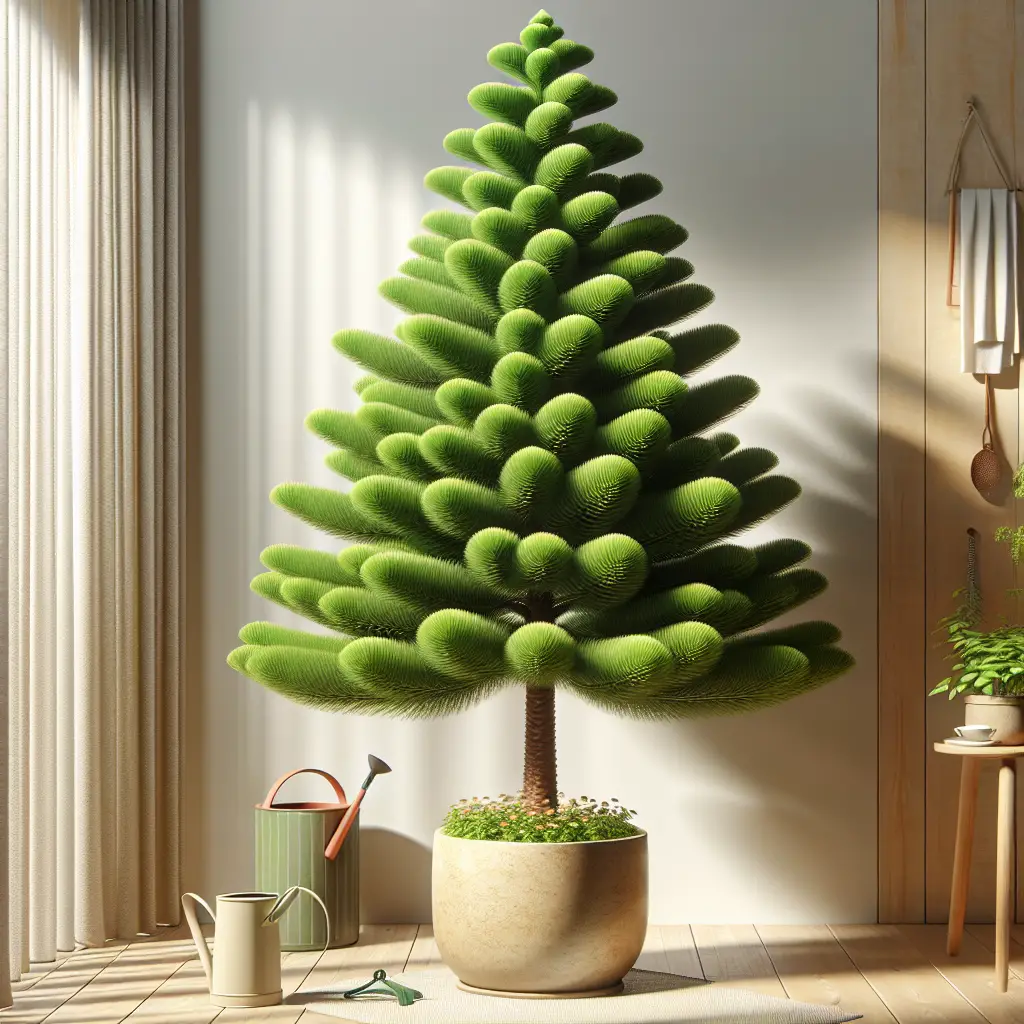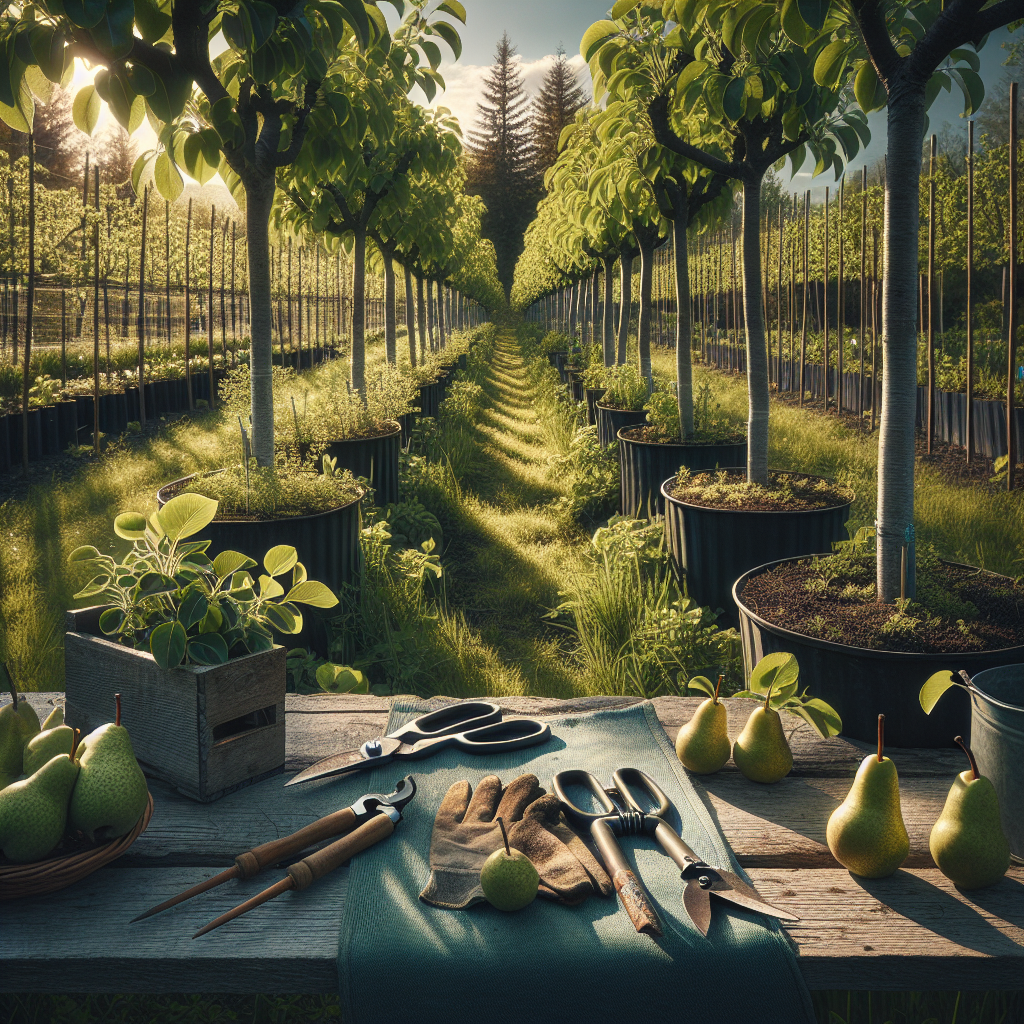Growing a Healthy Indoor Norfolk Pine: Care and Tips
Updated July 9, 2024 at 10:18 pm

Introduction to Indoor Norfolk Pine Care
Known for their pyramid-shaped crown and the ability to thrive indoors, Norfolk Pines (Araucaria heterophylla) are a wonderfully festive choice for anyone looking to add a touch of greenery to their indoor space. Commonly mistaken as a true pine, Norfolk Island pines are actually conifers hailing from the South Pacific. These majestic plants can bring in a slice of tropical forestry into your living room. With their soft, symmetrical branches and a resilient nature, Norfolk Pines are not just holiday plants but can be treasured all through the year. Let’s walk through the essentials of keeping your Norfolk Pine robust and lush.
- Pet Friendly: Good news for pet owners! Norfolk Pines are generally considered non-toxic to cats and dogs. However, their needles may cause mild irritation if ingested, so it’s best to keep an eye on your furry friends around this plant.
- Light Requirements: Bright, indirect light is ideal for Norfolk Pines. They thrive in a sunny spot where the light is filtered through a sheer curtain or blinds to avoid scorching their foliage.
- Watering: Keeping the soil evenly moist is key. Water your Norfolk Pine when the top inch of soil feels dry to the touch, and make sure pots have drainage holes to prevent waterlogging.
- Humidity: As tropical plants, they enjoy higher humidity levels. A room humidifier or a pebble tray can help increase the moisture in the air around them.
- Temperature: Norfolk Pines prefer temperatures between 65 to 70 degrees Fahrenheit and should be protected from drafts and sudden temperature changes.
- Difficulty: They are a beginner-friendly plant, but attention to their light and humidity needs can be crucial for their wellbeing.
What Soil Mix is Best for Norfolk Pine?
Choosing the right soil mix for Norfolk Pine is vital for its health and growth. These plants prefer a well-draining soil mix that retains moisture without becoming soggy. A standard potting mix combined with some perlite or sand can create the perfect environment for their roots to thrive. Organic materials like peat moss also enhance the soil’s structure, providing aeration and sufficient nutrients.
One product that garden enthusiasts often recommend is the Miracle-Gro Indoor Potting Mix. It’s designed to be less prone to gnats and has added fertilizers suitable for indoor plants. Many users appreciate that it provides a good balance of drainage and water retention, crucial for sensitive Norfolk Pines.
- Pros:
- Formulated specifically for indoor plants
- Contains no compost or bark, which are known to shelter fungus gnats
- Includes coconut coir, which holds and releases water as needed
- Cons:
- Some users report that the mix retains more moisture than preferred. It’s essential to monitor watering closely to avoid over-hydration.
Find This and More on Amazon
How Often Should I Water My Norfolk Pine?
Watering your Norfolk Pine correctly is crucial for preventing root rot and ensuring it stays healthy. The watering frequency will depend largely on the light, temperature, and humidity levels in your home. As a general rule of thumb, water when the top inch of the soil feels dry, which might be once a week or less. In winter, when the plant’s growth slows down, you will likely need to water it less frequently. Always check the soil moisture level before watering.
How Much Light Does a Norfolk Pine Need?
Norfolk Pines need plenty of bright, indirect light to grow well. A spot near a south-facing window with a sheer curtain to diffuse direct sunlight is ideal. These plants can also adapt to medium light conditions although their growth might slow down. If your plant is not receiving enough light, you might notice the lower branches turning brown and dropping. To avoid this, make sure your Norfolk Pine gets the light it craves. In case natural light is insufficient, consider using artificial plant lights. These can supplement the light, especially during darker winter months.
Avoiding Common Pitfalls with Norfolk Pines
Caring for Norfolk Pines is relatively straightforward, yet there are some common issues to watch out for:
- Browning Tips: This could be due to dry air, under-watering or over-watering. Check the soil to adjust your watering schedule and consider increasing humidity around the plant.
- Leaning Trunk: If your Norfolk Pine is leaning, it might be seeking more light. Rotate it regularly to ensure even growth, and make sure it’s situated in a bright spot.
- Yellowing Needles: Over-watering or poor drainage can cause the needles to turn yellow and fall off. Ensure your plant is in a well-draining pot and you’re not watering it too frequently.
- Pest Issues: Keep an eye out for common pests such as spider mites or mealybugs. Regular inspection and prompt treatment with insecticidal soap or neem oil can keep these at bay.
Fertilization and Seasonal Care
Your Norfolk Pine will benefit from regular fertilization during the spring and summer months, which are its active growing seasons. A balanced, water-soluble houseplant fertilizer applied once a month should suffice. Be sure to follow the package directions for appropriate amounts.
During the winter, the plant’s growth slows down, and fertilization should be reduced or stopped until the return of the growing season. While they are hardy, Norfolk Pines can be sensitive to the accumulation of salts from fertilizer in the soil, so it’s a good idea to flush the soil occasionally with water to prevent this.
Pruning and Maintenance: Keeping Your Norfolk Pine Tidy
Pruning your Norfolk Pine is usually not necessary as this can spoil its natural shape and beauty. If you need to remove any dead or damaged branches, do so carefully, cutting close to the trunk but not into it. If your Norfolk Pine outgrows its space, rather than topping it (which is not recommended), consider relocating it to a spot with more vertical space. Regular dusting of the leaves will help the plant access light better and prevent pest infestations.
When and How to Repot Your Indoor Norfolk Pine
Norfolk Pines grow rather slowly, so you won’t need to repot them very often—usually every couple of years or when you see roots coming out of the drainage holes. When you do repot, choose a container that’s just an inch or two larger in diameter than the current one, as too much space can invite over-watering issues. Use fresh, well-draining soil and be gentle with the roots during the process.
Adding Humidity for a Thriving Plant
In their native environment, Norfolk Pines enjoy humid conditions. In a home environment, particularly in winter when indoor heating can dry the air, additional humidity may be needed. A humidifier, misting, or a pebble tray with water can help to keep the ambient humidity at a level that will keep your Norfolk Pine happy. It’s also beneficial to group plants together to create a microclimate with higher humidity.
Is My Norfolk Pine Suited for Outdoor Living?
While Norfolk Pines can be placed outdoors during the warmer months in some climates, they are not frost-hardy and should be brought inside before temperatures drop below 50 degrees Fahrenheit. When transitioning your plant outdoors, do so gradually to acclimate it and avoid placing it in direct sunlight immediately to prevent sunburn.
Final Thoughts and Care Summary
Taking care of an indoor Norfolk Pine can be a rewarding experience. They don’t just add to the aesthetic of your home, but they also improve the air quality and bring in a sense of peace and tranquility. With proper light, watering, humidity, and temperature conditions, your Norfolk Pine will grow into a towering beauty over the years. Remember, patience and consistent care are key to cultivating a healthy indoor environment for your green companion.
By staying attuned to the needs of your Norfolk Pine and responding to any changes in its condition, you’re sure to have a robust, thriving plant that adds joy and a touch of nature’s splendor to your indoor space. Enjoy the journey of growing your Norfolk Pine, and don’t hesitate to reach out to plant communities or gardening experts if you find yourself in need of advice. Happy planting!
Choosing the Perfect Location for Your Norfolk Pine
Finding the right spot for your Norfolk Pine can be a delightful puzzle. While they don’t demand constant attention, the spot you choose can greatly impact their health and happiness. What you’re looking for is a bright area that simulates their natural, sunny habitat without exposing them to harsh direct sunlight for prolonged periods. An east or west-facing window might be just the place, with the gentle morning or evening sun providing enough light without the intensity of a midday blaze.
Also, be mindful of air currents. These gorgeous plants dislike fluctuating temperatures and drafts, so setting them near open windows, doors, or heating and cooling vents can lead to stress, and no one wants a stressed-out pine!
Maximizing Growth: Top Tips for a Lush Norfolk Pine
To get the most out of your Norfolk Pine, think about its comfort. Like a favorite pair of shoes, your Norfolk Pine will display optimum growth when it’s feeling its best. Aside from watering and lighting, you’ll want to give it as much humidity as you can. These plants originate from a tropical paradise, so they crave that moist air. If your home runs dry, especially during winter months, consider investing in a humidifier. The Levoit Humidifier comes highly recommended, offering both warm and cold mist options to cover all conditions and preferences.
In practical terms, the Levoit model’s real charm lies in its large water tank that allows for extensive run times without constant refills, which is a huge convenience. People also like the intuitive touch controls and remote operation, making it easier to adjust settings to keep your Norfolk Pine living its best life. However, some reviews mention that it can be quite large for smaller spaces, so you’ll want to check you have room to accommodate it. Overall, boosting the humidity can prevent your Norfolk Pine’s needles from drying out and turning brown—a common issue in less-than-ideal humidity levels.
Pros
- Large water tank for longer operation times
- Both warm and cold mist options
- Intuitive controls and remote operation
Cons
- May be too large for small rooms or spaces
Find This and More on Amazon
Addressing Pests and Diseases: Prevention Over Cure
Even the healthiest indoor garden can occasionally be attacked by pests or fall victim to disease. For your indoor Norfolk Pine, stay one step ahead of the game by adopting a proactive approach. Prevention is always easier than cure. Keep your plant clean by gently wiping the needles to remove dust, which can attract pests and impede photosynthesis. Avoid over watering, as soggy soil is an open invitation for root rot and fungal infestations.
When it comes to pests like spider mites or scale insects, vigilance is key. At the first sign of trouble, isolate your plant—pesky critters spread fast! Treatments such as insecticidal soap or neem oil are gentle on the plant but deadly for pests. For neem oil, the Organic Neem Bliss is widely praised by plant lovers. Its 100% cold-pressed oil is effective against a broad range of pests without introducing harsh chemicals into your home.
Reviewers rave about its potency and versatility, not just for Norfolk Pines, but for a whole host of plant pests. A downside noted by some is its smell, which can be quite strong, but often deemed a small price to pay for the peace of mind it brings.
Pros
- Effective against a wide variety of pests
- 100% organic and non-toxic
- Can be used as a preventative measure
Cons
- Some might find the smell unpleasant
Find This and More on Amazon
Propagating Norfolk Pines: Can It Be Done?
Maybe you’ve had your Norfolk Pine for a while, and you’re thinking about propagating it to increase your collection—or perhaps to share with friends. Unfortunately, Norfolk Pines are not easily propagated by cuttings as some other houseplants are. The reliable method for propagation is through their seeds.
Propagation via seeds can be a fun experiment but requires patience and the right environmental conditions. If you’re up for the challenge, remember that seeds will need a consistently warm and moist environment to germinate. A greenhouse or a simple setup including a seedling heat mat and a humidity dome could do the trick. The VIVOSUN seedling heat mat is a favorite among gardening enthusiasts for its reliable performance and built-in thermostat control, facilitating the precise conditions young seedlings demand.
Online reviewers appreciate this heat mat’s durability and the fact it can raise the soil temperature above the ambient by approximately 10-20°F, which is ideal for sprouting seeds like those of the Norfolk Pine. A common cautionary point, though, is to keep it away from water splashes as, with any electrical device, safety comes first.
Pros
- Consistent heating with thermostat control
- Durable and waterproof construction
- Increases germination success rate
Cons
- Should be used cautiously to avoid water contact with the electrical parts
Find This and More on Amazon
Decorating with Norfolk Pines: Balancing Aesthetics and Health
The natural elegance of Norfolk Pines makes them a standout in any indoor landscape. However, when it comes to using these beautiful plants as part of your decor, it’s important to balance looks with the health of the plant. Avoid placing decorations that may harm the plant’s delicate branches or obstruct its light source. If you’re dressing up your Norfolk Pine for the holidays, opt for lightweight ornaments that won’t put pressure on the limbs and LED lights that don’t emit much heat.
It might be tempting to place your Norfolk Pine in that empty corner of your room, but remember, these are not just decorative items; they’re living plants that need proper care. Paying attention to their needs when incorporating them into your home design will ensure they stay healthy and attractive for years to come.
Selecting the Right Pot for Your Norfolk Pine
One might not think the pot you choose for your Norfolk Pine matters much, but it’s actually pretty significant. The pot is not just a home for your plant; it plays a crucial role in drainage and, therefore, the overall health of the roots. We’ve mentioned before that Norfolk Pines demand well-draining soil, so it stands to reason that they require pots to match.
A favorite pot choice among indoor plant enthusiasts is the classic terracotta pot, known for its breathability and natural look. The porous nature of terracotta allows for air and water to move through the walls, promoting healthy roots and preventing over-watering to some extent. Ensure you select a pot with adequate drainage holes, and avoid overly large pots, which can hold too much water and potentially lead to root rot.
While they’re known for their practical benefits, some people dislike how quickly terracotta can dry out in very warm, dry conditions. In such cases, consider a glazed ceramic pot which retains moisture a little better while still providing a safe haven for your plant’s roots. Just watch out—they can be heavy, and once filled with a mature Norfolk Pine, moving them can be quite a task.
Pros
- Allow for good air and moisture circulation
- Classic, natural aesthetic
- Help prevent over-watering
Cons
- Can dry out quickly in certain conditions
- Glazed pots can be heavy and hard to move
Creating the Ideal Indoor Ecosystem for Your Norfolk Pine
Eager to really dive into the indoor plant world? Your Norfolk Pine is a great starting point for creating a lush indoor ecosystem. Complement it with other tropical plants like ferns or spider plants that have similar humidity and light requirements. This doesn’t just create an appealing visual—grouping these plants together can raise the humidity level around them, which is good for their overall health.
Remember to allow enough space between your plants to enable good air circulation and reduce the risk of pest infestations. It’s quite the balancing act, finding that perfect plant-placement that looks good, allows each plant their space, and creates a microclimate beneficial to all. But when you get it right, your indoor garden becomes a serene haven you’ll never want to leave.
Learning from Your Norfolk Pine: Attentiveness in Plant Care
As you embark on this journey with your Norfolk Pine, remember that no guide can beat attentiveness and observation. Each plant, like each home, is unique. While you can follow general care instructions to the letter, it is your daily observations that will teach you the most. Is your Norfolk Pine leaning towards the light, or are its needles browning at the tips? Your plant is communicating its needs to you.
These subtle signs become more recognizable as you gain experience. Sometimes, books and blogs don’t have all the answers, but an observant plant parent usually does. So keep an eye on your green friend and respond to its feedback; this is how you’ll become a true plant whisperer.
Taking care of an indoor Norfolk Pine is a fulfilling endeavor that brightens your home and nurtures your green thumb. By offering proper soil, light, and humidity, monitoring watering and fertilization, and keeping an eye out for pests and diseases, you’ll create a nurturing environment for your plant. Remember, good plant care is less about having a green thumb and more about being a good observer and a responsive caretaker. Your Norfolk Pine depends on you, and with the right care, it will be a magnificent centerpiece in your home for many years.
To all plant lovers, novices, or aficionados alike, I hope this detailed guide has provided you with the insight you need to care for your indoor Norfolk Pine. Embrace the process, enjoy the growth, and never stop learning. Your home and your indoor oasis will thank you. Happy growing!
Shop more on Amazon

